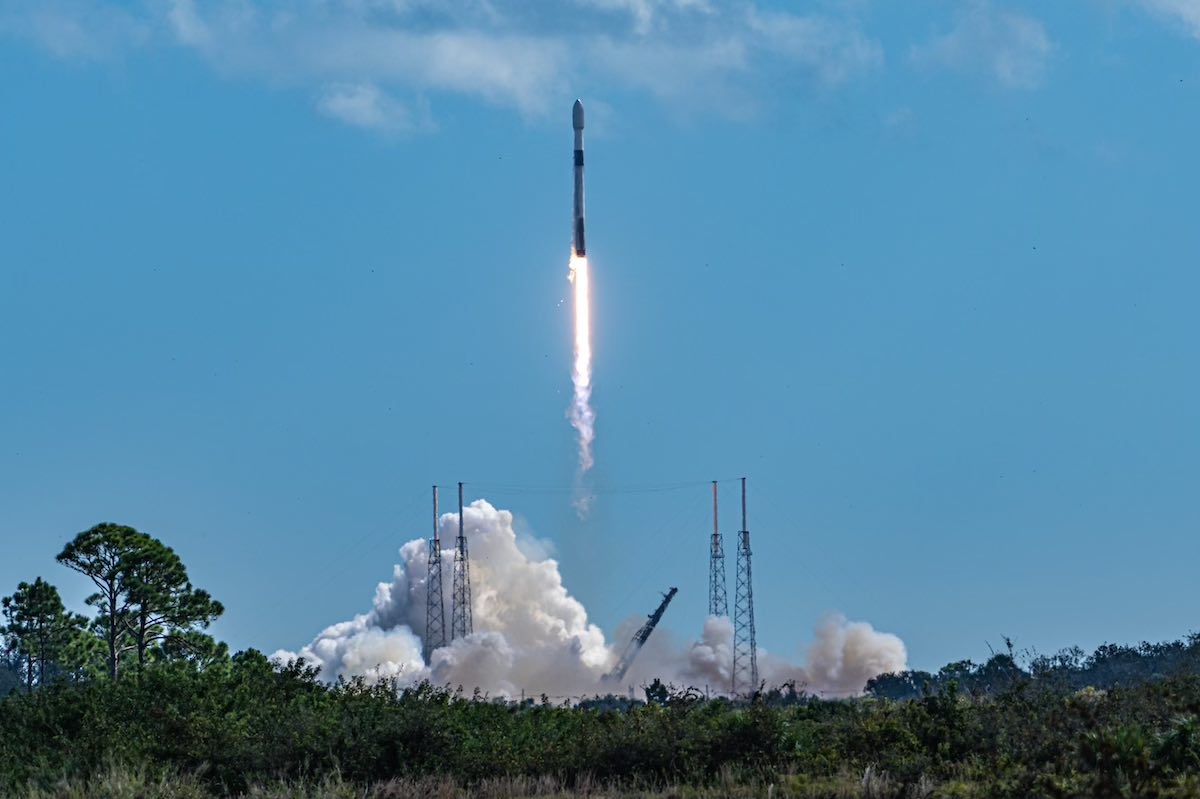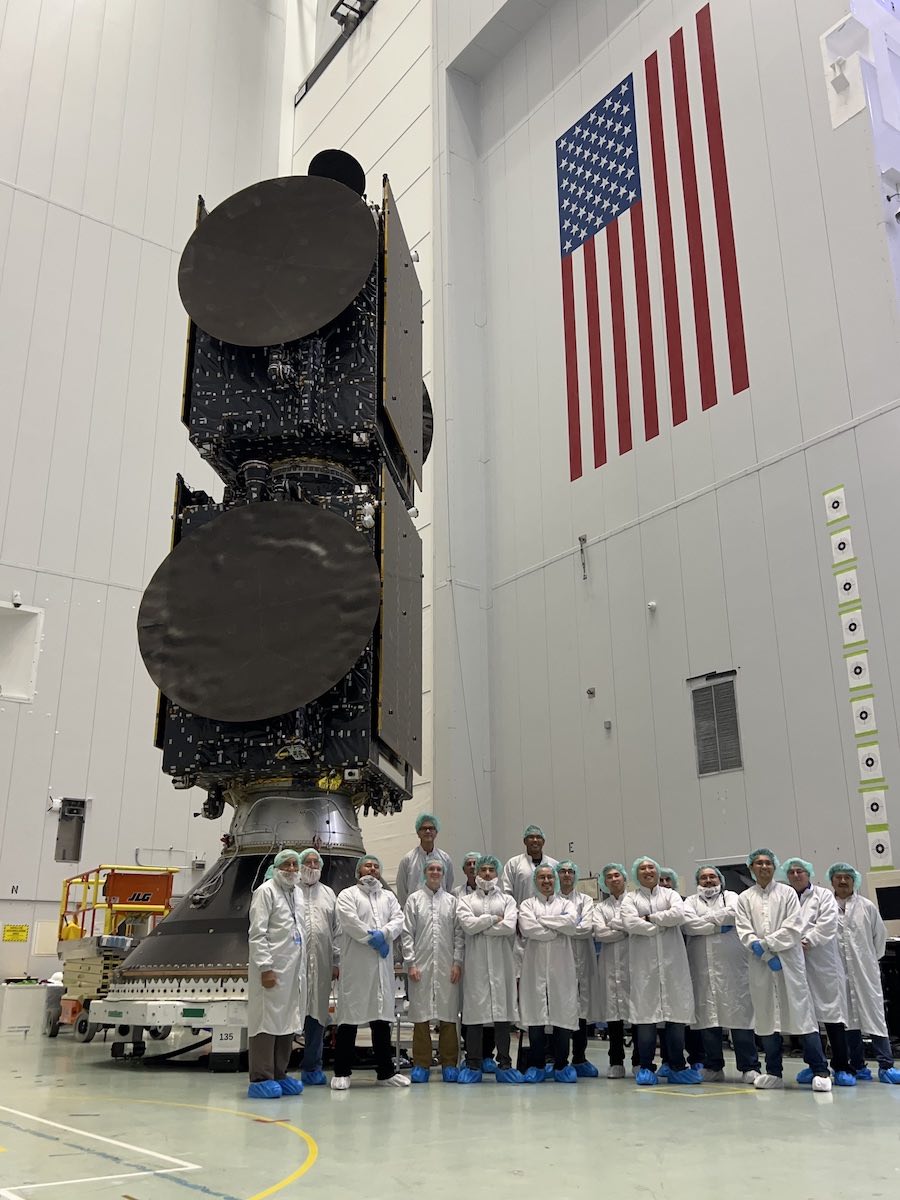Live coverage of the countdown and launch of a SpaceX Falcon 9 rocket from Space Launch Complex 40 at Cape Canaveral Space Force Station, Florida. The Falcon 9 rocket launched Intelsat’s Galaxy 31 and 32 geostationary communications satellites. Follow us on Twitter.
SFN Live
SpaceX launched one of its reusable Falcon 9 rocket boosters for the last time Saturday on a rare expendable mission for Intelsat, devoting all of the launcher’s propellant toward placing a pair of television broadcasting satellites into orbit. Intelsat says it paid SpaceX an additional fee for the expendable mission.
The Falcon 9 rocket lifted off at 11:06 a.m. EST (1606 GMT) Saturday after a four-day delay caused by Hurricane Nicole.
The two Intelsat communications satellites on top of the 229-foot-tall (70-meter) Falcon 9 rocket are heading into geosynchronous orbit to begin missions expected to last more than 18 years providing video broadcasting services over North America. The Galaxy 31 and 32 satellites were built by Maxar, and are part of Intelsat’s program to replace older communications satellites as the Federal Communications Commission transitions a segment of C-band spectrum for use by 5G cellular network services.
Intelsat launched the Galaxy 33 and 34 satellites on a Falcon 9 rocket Oct. 8, the first two of seven new C-band satellites that are part of the transition program. The company has three more new C-band broadcasting satellites under construction for launches on Falcon 9 and Ariane 5 rockets in the coming months.
For Saturday’s mission, SpaceX’s Falcon 9 rocket took off from Cape Canaveral and headed east over the Atlantic Ocean, targeting a “supersynchronous” transfer orbit for deployment of the Galaxy 31 and 32 satellites. The elliptical transfer orbit was expected to range between a few hundred miles above Earth up to near 37,000 miles (60,000 kilometers) in altitude, according to Jean-Luc Froeliger, senior vice president of space systems at Intelsat.
A member of SpaceX’s launch control team confirmed after the mission that the rocket achieved the expected orbit.
The Galaxy 31 and 32 satellites were stacked one on top of the other for launch. Galaxy 32 deployed from the upper position on the rocket first at T+plus 33 minutes, 31 seconds. Five minutes later, Galaxy 31 separated from the Falcon 9’s upper stage.
Intelsat decided to pay SpaceX extra money to get all of the Falcon 9’s lift capability, reducing the amount of fuel the Galaxy 31 and 32 satellites need to burn to reach their final operating positions in geostationary orbit. SpaceX typically reserves some of the booster’s propellant for landing maneuvers, but on this mission, all of the rocket’s fuel was burned during the climb into space. The reusable first stage booster, designated B1051, made its 14th and final flight.
The booster debuted March 2, 2019, with the first unpiloted test flight of SpaceX’s Crew Dragon capsule, a precursor to SpaceX’s later astronaut missions. It launched again in June 2019 with Canada’s Radarsat Constellation Mission. Later in its career, the booster launched SiriusXM’s SXM 7 radio broadcasting satellite, and flew on 10 missions carrying SpaceX’s own Starlink internet satellites.
Most recently, the Falcon 9 booster launched July 17 on a Starlink mission.
The two new Intelsat satellites are based on Maxar’s 1300-series satellite design, and it’s the first time two large Maxar-built communications have launched on the same rocket in a stacked configuration. The dual-satellite stack weighs about 14,500 pounds, or 6.6 metric tons, fully fueled for launch, according to Froeliger.
The Galaxy 31 and 32 satellites will use their own propellants to move from the elliptical transfer orbit achieved by the Falcon 9 rocket into a circular geostationary orbit directly over the equator, consuming fuel that otherwise could be used for stationkeeping throughout their missions.
“SpaceX is not going to be able to reuse the the first stage, so you have to pay a premium for an expendable launch vehicle,” Froeliger said in a press conference Monday previewing the Galaxy 31/32 launch. “The expendable launch vehicle was needed for this mission due to the characteristics of the Maxar satellites. This is the first time Maxar launches a stack of two 1300s together. And in order for us to achieve a good orbital lifetime, meaning greater than 15 years, we had to go to a Falcon 9 expendable, and there’s a premium to be paid.”
“You pay extra when it’s expendable,” Froeliger said in a previous interview with Spaceflight Now. “From a business point of view, you may also get a booster that has flown many times that they may retire anyhow, but you’re still paying because you pay for the expendable.”

During Saturday morning’s countdown, the Falcon 9 launcher was filled with a million pounds of kerosene and liquid oxygen propellants in the final 35 minutes before liftoff.
After teams verified technical and weather parameters were all “green” for launch, the nine Merlin 1D main engines on the first stage booster flashed to life with the help of an ignition fluid called triethylaluminum/triethylborane, or TEA-TEB. Once the engines ramped up to full throttle, hydraulic clamps opened to release the Falcon 9 for its climb into space.
The nine main engines produced 1.7 million pounds of thrust for more than two-and-a-half minutes, propelling the Falcon 9 and Intelsat’s Galaxy 31 and 32 satellites into the upper atmosphere. Then the booster stage shut down and separated from the Falcon 9’s upper stage to begin an uncontrolled fall into the Atlantic.
The booster was not fitted with SpaceX’s recovery hardware, such as titanium grid fins or landing legs. And SpaceX did not deploy one of its drone ships for the expendable mission.
SpaceX was expected to attempt to recover the Falcon 9 rocket’s payload fairing after the nose cone’s two clamshell halves parachute into the sea downrange from Cape Canaveral. The payload fairing jettisoned from the rocket about three-and-a-half minutes into the flight, shortly after ignition of the Falcon 9’s upper stage engine.
The Falcon 9 rocket fired its upper stage engine two times to inject the two Intelsat spacecraft into an elliptical geostationary transfer orbit, then the satellites deployed from the rocket one at a time. Galaxy 31 and 32 will unfurl their solar panels and begin maneuvers with their own propulsion systems to circularize their orbits at geostationary orbit more than 22,000 miles (nearly 36,000 kilometers) over the equator.
Intelsat will operate the Galaxy 31 satellite in a slot at 121 degrees west longitude, replacing the Galaxy 23 satellite launched in 2003. Galaxy 32 will replace the Galaxy 17 satellite, launched in 2007, at 91 degrees west longitude.
The orbital maneuvers required to place the Galaxy 31 and 32 satellites into their circular geostationary orbit will take about two weeks. After in-orbit testing, Froeliger said Galaxy 31 is scheduled to enter commercial service in January, followed by Galaxy 32 in February.
“Our customer base is media, so anybody using TV in the U.S., you can bet there’s a great probability that your channel is going to be on either one of these two satellites, or some other Galaxy satellite that we have over the U.S.,” Froeliger said. “These satellites are replacing older satellites that are running of fuel, and they’re replacing with a little more newer technology, so they will have higher power allowing the customer to use smaller receive antennas and have better performance, especially in the case of bad weather.”

ROCKET: Falcon 9 (B1051.14)
PAYLOAD: Galaxy 31 and 32 communications satellites
LAUNCH SITE: SLC-40, Cape Canaveral Space Force Station, Florida
LAUNCH DATE: Nov. 12, 2022
LAUNCH WINDOW: 11:06 a.m. – 1:06 p.m. EST (1606-1806 GMT)
WEATHER FORECAST: 90% probability of acceptable weather
BOOSTER RECOVERY: None
LAUNCH AZIMUTH: East
TARGET ORBIT: Geostationary transfer orbit
LAUNCH TIMELINE:
-
- T+00:00: Liftoff
- T+01:12: Maximum aerodynamic pressure (Max-Q)
- T+02:43: First stage main engine cutoff (MECO)
- T+02:46: Stage separation
- T+02:53: Second stage engine ignition
- T+03:32: Fairing jettison
- T+08:05: Second stage engine cutoff (SECO 1)
- T+26:50: Second stage engine restart
- T+28:00: Second stage engine cutoff (SECO 2)
- T+33:31: Galaxy 32 separation
- T+38:41: Galaxy 31 separation
MISSION STATS:
- 185th launch of a Falcon 9 rocket since 2010
- 194th launch of Falcon rocket family since 2006
- 14th launch of Falcon 9 booster B1051
- 158th Falcon 9 launch from Florida’s Space Coast
- 103rd Falcon 9 launch from pad 40
- 158th launch overall from pad 40
- 126th flight of a reused Falcon 9 booster
- 3rd SpaceX launch for Intelsat
- 51st Falcon 9 launch of 2022
- 52nd launch by SpaceX in 2022
- 49th orbital launch attempt based out of Cape Canaveral in 2022
Email the author.
Follow Stephen Clark on Twitter: @StephenClark1.
